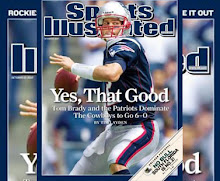When Mexico and the United States meet, the heavens always rumble — although not necessarily like the nasty storm that blew in Wednesday night before the home team defeated the Mexicans, 2-0, in a World Cup qualifying match.
The rivalry has enough crackle of its own without any help from the winds and heavy rain that blew through at about 5:20 p.m., just when American and Mexican fans were heading toward Crew Stadium.
For a while during the downpour, spectators were urged to stay in their cars, but then the teams took the field on schedule, and the fans braved the elements, even with tornado warnings earlier and falling temperatures during the game.
The United States played wisely most of the time, and produced two finishing goals by Michael Bradley, the son of Coach Bob Bradley, in the 43rd and 92nd minutes. Both goals were the result of hard work and pressure, not easy under the conditions.
The United States has now won nine and drawn two in the last 11 home meetings since March 1999, including three consecutive 2-0 victories over Mexico in World Cup qualifying, at Crew Stadium — in 2001, 2005 and Wednesday.
Mexico still has the edge, with 29 victories and 11 draws in 55 matches in the competition, which has become so intense that Frankie Hejduk, one of the American mainstays, compares it to an American football rivalry. Hejduk, who plays for the defending champion Columbus Crew of
Major League Soccer, gets to feel that other rivalry up close.
“This is just like the — can I say the word? The M word?” Hejduk said, joking on Tuesday, knowing that people in Ohio do not even like to utter the name of their rival from the neighboring state of Michigan.
That game every November brings out the extreme partisan in this part of the world. Mexican fans found their way to Columbus on Wednesday, even though the American federation does its best to sell tickets only to American fans. Dozens of fans wearing green Mexican jerseys were walking around a generally desolate downtown.
“If we play in L.A., you’ve got 25,000 Mexican fans,” Hejduk said Tuesday, noting that Mexican fans would find a way to attend any Mexico game in the southern tier of the United States.
“You’re hearing cheers for the other team,” Hejduk, 34, said, repeating the wisdom that causes matches to be placed in heartland cities like Columbus or Birmingham, Ala., or Nashville.
“Here, we’ve got the 12th man,” Hejduk said. He has been part of the national team going back to the 1998 debacle in France, the three humiliating losses in the World Cup.
“We’ve had their number the last few times,” he said of Mexico, adding that it would be fine with him if the Mexicans did have a psychological disadvantage here, “if that’s what it takes.” But he added, “It’s a difficult game.”
Hejduk heard that Mexican entrepreneurs were selling voodoo dolls back home, sponsored by an American company, Blockbuster, instructing fans to stick pins where they wished to inflict pain. “It tells me they’re passionate,” Hejduk said with a smile. “No pain yet. I’m going to get one of those dolls.”
Hejduk, who has scored two of his six international goals against Mexico, was one of the best American players Wednesday, running hard from his right back position. The United States chose to play with the strong wind at its back in the first half but averted trouble in the third minute when Tim Howard made a kick save.
The United States mostly controlled the ball after that, focusing on possession and short passes. Then Hejduk earned a corner kick with a hard run down the right side, tangling with a Mexican defender, both of them slamming into the advertising boards.
DaMarcus Beasley, who was all over the field, swung a long, left-footed kick from the right corner that curled back to Landon Donovan, who headed the ball back across. Oguchi Onyewu headed it on goal, and Bradley slotted home the rebound for a 1-0 lead.
Playing into the wind in the second half, the United States used its height to control the shorter kicks. Mexico did launch an attack of a different kind when the Mexico captain Rafael Márquez kicked Howard in the right thigh on his way down, and earned a red card in the 67th minute, putting the Mexicans down a player.
The United States dominated, and then in extra time outworked the outmanned Mexicans, with
Jozy Altidore and Donovan setting up Bradley’s second goal.
The major negative for the United States was that Howard was hit with a yellow card for delay of game after being kicked by Márquez, and must now sit out the next match, in El Salvador on March 28. This meeting was the first in the final round of qualifying for the 2010 World Cup in South Africa. While both teams should be among the three nations from a six-team group guaranteed to qualify, every game between them is an event.
The two rivals are expected to meet next in Azteca Stadium, on Aug. 28. There may not be February wind and rain, but it will be noisy, and the place will rumble.











